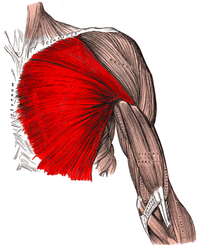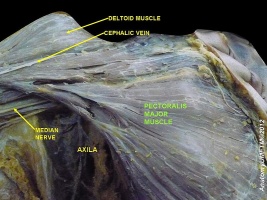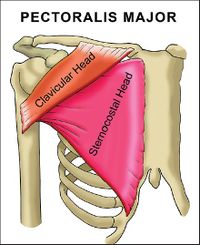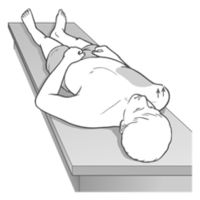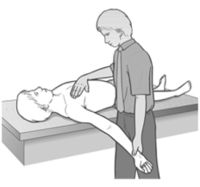Description
The pectoralis major is the most superficial muscle in the pectoral region. It is large and fan shaped, and is composed of a sternal head and a clavicular head.[1] The pectoralis major is active in deep or forced inspiration, but not expiration. [2]
Origin
- Clavicular head – originates from the anterior surface of the medial clavicle.
- Sternocostal head – originates from the anterior surface of the sternum, the superior six costal cartilages and the aponeurosis of the external oblique muscle[2].
Insertion
The upper and lower fibers of pectoralis major insert to the crest of greater tubercle of the humerus. Upper fibers are more anterior and caudal on the crest, while posterior fibers twist on themselves and are more posterior and cranial than the upper fibers.[2]
Nerve supply
Nerve supply to pectoralis major comes from brachial plexus.
Nerve of the upper fibers: Lateral pectoral nerve, C5,6,7.
Nerves to the lower fibers: Lateral and medial pectoral nerve, C6, 7,8, T1. [2]
Artery
pectoral branch of the thoracoacromial trunk
Function
With the origin fixed, the pectoralis major adducts and medially rotates the humerus. With the insertion fixed, it may assist in elevating thorax, as in forced inspiration. In crunch-walking or parallel-bar work, it will assist in supporting the weight of the body. [2]
Clinical relevance
Weakness
Upper part of pectoralis major:
Decrease the ability to draw the arm in horizontal adduction across the chest, making it difficult to touch the hand to the opposite shoulder. Decreases the strength of shoulder flexion and medial rotation.
Lower part of pectoralis major:
Decreases the strength of adduction obliquely toward the opposite hip.From a supine position, if the subjects arm is placed diagonally overhead, it will be difficult to lift arm from a table. The subject will also have difficulty holding any large or heavy object in both hands either at or near waist level.[2]
Shortness
Upper part of pectoralis major:
The range of motion in horizontal abduction and lateral rotation of the shoulder is decreased. Shortness of the pectoralis holds the humerus in medial rotation and adduction and, secondarily, results in abduction of the scapula from the spine.
Lower part of pectoralis major:
A forward depression of the shoulder girdle from the pull of pectoralis major on the humerus often accompanies the pull of the tight pectoralis minor on the scapula. Flexion and abduction ranges of motion overhead are limited. [2]
- Observing the patient lies supine with upper arms on the table, hands resting palm down on the lower abdomen. The practitioner observes from the head and notes whether either shoulder is held in an anterior position in relation to the thoracic cage. If one or both shoulders are forward of the thorax, pectoralis muscles are short
Trigger Points
The trigger points in the pectoralis major muscle can produce symptoms that are nearly identical to the pain associated with having a heart attack or angina pectoris. Referred pain from these trigger points is experienced in the chest, front of the shoulder, down the inside of the arm, and along the inside of the elbow. They may also produce tenderness in the breast and nipple hypersensitivity.[3]
Assessment
Palpation
Power
Upper (clavicular) part of pectoralis major:
Position: Supine. The examiner holds the opposite shoulder firmly on the table. The triceps maintains the elbow on the extension.
Test: Starting with the elbow extended and with the shoulder in 90 degrees flexion and slight medially rotation, the humerus is horizontally adducted towards the sternal end of clavicle.
Pressure: Against the forearm in direction of horizontal abduction.
Lower (sternal) part of pectoralis major:
Position: Supine. The examiner places one hand on the opposite iliac crest to hold the pelvis firmly on the table.
Test: Starting with the elbow extended and with the shoulder in flexion and slight medially rotation, adduction of the arm obliquely toward the opposite iliac crest.
Pressure: Against the forearm obliquely, in a lateral and cranial direction.[2]
Length
Upper (clavicular) part of pectoralis major:
Position: Supine with the knees bent and the low back flat on the table.
Test: The examiner places the subjects arm in horizontal abduction, with the elbow extended and the shoulder in lateral rotation (palm upward).
Normal length: Full horizontal abduction with lateral rotation, the arm flat on the table without trunk rotation.In this position the tendon of pectoralis major at the sternum should not be found to be unduly tense, even with maximum abduction of the arm, unless the muscle is short.Shortness:The extended arm does not drop down to table level. Limitations may be recorded as slight, moderate or marked; measured in degrees using goniometer or measured in inches using a ruler to record the number of inches between the table and lateral epicondyle.
Lower (sternal) part of pectoralis major:
Position:Supine with the knees bent and the low back flat on the table.
Test: The examiner places the subjects arm in position of approximately 135 degrees of abduction (in line with the lower fibers), with the elbow extended. The shoulder will be in a lateral rotation.
Normal length: Arm drops to table level, with the low back remaining flat on the table.
Shortness:The extended arm does not drop down to table level. Limitations may be recorded as slight, moderate or marked; measured in degrees using goniometer or measured in inches using a ruler to record the number of inches between the table and lateral epicondyle.[2]
Treatment
Strengthening
Stretching
Manual therapy
Resources
See also
- ↑ ↑ 2.02.12.22.32.42.52.62.72.8 Kendall F, McCreary E, Provance P,Rodgers M,Romani W. Muscles:Testing and function with posture and pain. 5th ed. Philadelphia: Lippincott Williams & Wilkins, 2005.
- ↑ function gtElInit() { var lib = new google.translate.TranslateService(); lib.setCheckVisibility(false); lib.translatePage('en', 'pt', function (progress, done, error) { if (progress == 100 || done || error) { document.getElementById("gt-dt-spinner").style.display = "none"; } }); }
Ola!
Como podemos ajudar?

